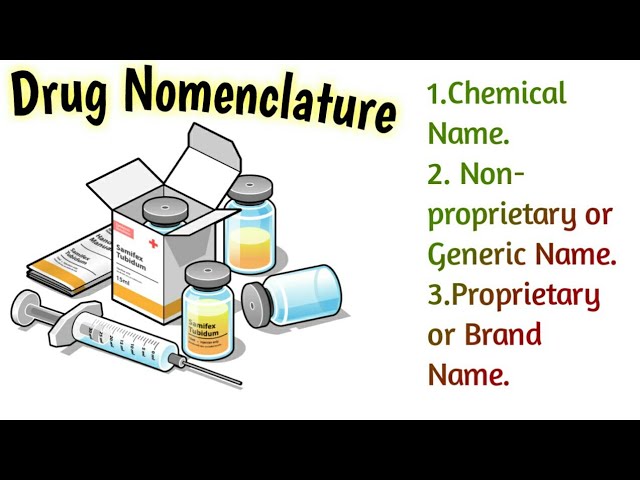Table of Contents
Drug nomenclature

A drug generally has three categories of names:
Chemical name
A code name, e.g. RO 15-1788 (later named flumazenil) may be assigned by the manufacturer for convenience and simplicity before an approved name is coined. It describes the substance chemically but is cumbersome and not suitable for use in prescribing. A code name can be used to identify a drug that has been given the name propan-2-ol for propranolol.
Non-proprietary name
It is a name that has been approved by a competent scientific organization or authority, such as the United States Adopted Name (USAN) council. A drug’s British Approved Name (BAN) is another example. The Recommended International Nonproprietary Name (rINN) is used by all WHO member nations to keep nonproprietary names of newer medicines consistent. The BAN for older medicines has also been updated to reflect the new rINN. Many older medicines, however, still retain multiple non-proprietary names, such as ‘meperidine’ and ‘pethidine,’ or ‘lidocaine’ and ‘lignocaine,’ for example. The authorized name may alternatively be referred to as the nonproprietary name until the medicine is incorporated in a pharmacopeia. It becomes the official name once it appears in an official publication. In everyday speech, the phrase generic name replaces the term nonproprietary name. This is wrong etymologically: the term “generic” should refer to the compound’s chemical or pharmacological category (or genus), such as phenothiazines, tricyclic antidepressants, aminoglycoside antibiotics, and so on. This misunderstanding, however, is commonly accepted and even utilized in the official language.
Proprietary (Brand) name
It’s the brand name given to the product by the producer, and it’s his property or trademark. Various manufacturers may use different proprietary names for the same medication, such as ALTOL, ATCARDIL, ATECOR, ATEN, BETACARD, LONOL, ATENOLOL, TENORMIN for atenolol. Brand names are intended to be memorable, brief, and evocative, such as LOPRESOR, which suggests a blood pressure-lowering medication. In the United States, timolol maleate eye drops are sold as TIMOPTIC, whereas in India, they are marketed as GLUCOMOL. Even the same manufacturer might sell the same medicine in various countries under different brand names. Furthermore, blended formulations have a variety of brand names.
Uniformity, convenience, economy, and better comprehension are all grounds for adopting the nonproprietary term in prescription (blockers propranolol, sotalol, timolol, pindolol, metoprolol, acebutolol, and atenolol are all blockers, but their brand names are not).
However, when it is critical to assure product consistency in terms of quality, bioavailability, and other factors, and especially when official quality control of produced items is lax, it is preferable to prescribe by a trusted brand name.
Make sure also check our amazing article: Introduction to Pharmacology